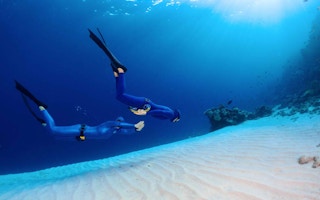The climate emergency is now a lived reality around the world. Weather extremes have dominated 2019 as if the planet wanted to underline the urgency of the upcoming climate summit in September.
This time, UN Secretary General Antonio Guterres has asked governments to come not with finely crafted speeches, but with real action plans. With students striking globally every week, the world is watching as Greta Thunberg sailed in to New York to deliver their demand for climate action now, their demand for a future.
We need drastic reductions in the use of fossil fuels and to accelerate our global transition to carbon neutral societies. But to fight climate change we also need healthy oceans.
The oceans naturally take in huge amounts of carbon dioxide and are a key defence against the worsening impacts of climate change. On his recent visit to the Pacific, the UN chief argued that “to address the intertwined challenges of climate change and ocean health, we need smart and far-reaching steps.”
That’s absolutely right, and one key step that is needed is a bold new Global Ocean Treaty, which is being negotiated this month at the UN.
The scope of this new global agreement could be huge: almost half of the planet. The High Seas, oceans beyond borders, cover more space on our planet than all continents combined.
“
The oceans naturally take in huge amounts of carbon dioxide and are a key defence against the worsening impacts of climate change.
Sadly, today these international waters are being ruthlessly exploited. In addition to climate change, pressures from overfishing, deep sea mining exploration, oil drilling and plastic pollution are pushing our oceans to the verge of collapse. Only around 1 per cent of the global seas are properly protected. There is no effective legal instrument that allows the creation of ocean sanctuaries—areas off-limits to harmful human activities—on international waters.
Scientists are clear that we need to protect at least 30 per cent of our global oceans by 2030 if we are to safeguard wildlife and to help mitigate the impacts of climate change. But that will only happen if an ambitious ocean treaty is adopted fast and opens the door to creating effective ocean sanctuaries in international waters.
All governments attending the UN Climate Summit in September should commit to adopting a strong Global Ocean Treaty in 2020.
At the ongoing negotiations at the UN, governments need to work together to ensure that a treaty can be adopted at the final negotiation session scheduled for the first half of next year. Many countries have already stated their support for a strong treaty.
Countries from Africa, the Pacific, Latin America and Europe, for example, agree that the Global Ocean Treaty should explicitly allow for the creation of protected areas internationally. Some governments—such as the US, Norway, Australia, Japan, Canada, New Zealand and Ecuador—however seem to favour a watered down treaty which wouldn’t be able to deliver the network of ocean sanctuaries that science demands.
During the current third negotiating session, these countries must rise to the challenge if they are to be seen as Ocean champions. Eyes are also on China, host of the 2020 biodiversity summit—CBD COP15—which will set the post 2020 biodiversity targets. And eyes will be on Russia, Iceland and Korea who so far have held the negotiations back.
There is no greater symbol of the urgency of climate action and its interconnectedness with our natural world than the boat carrying Greta Thunberg arriving in New York, a tiny speck on a vast sea. Our oceans sustain all life on Earth and they are a crucial ally against climate breakdown.
Tackling the climate emergency and protecting our oceans go hand-in-hand.
Jennifer is executive director of Greenpeace International. This story was published with permission from Thomson Reuters Foundation, the charitable arm of Thomson Reuters, that covers humanitarian news, climate change, women’s and LGBT+ rights, human trafficking and property rights. Visit http://news.trust.org/climate.











